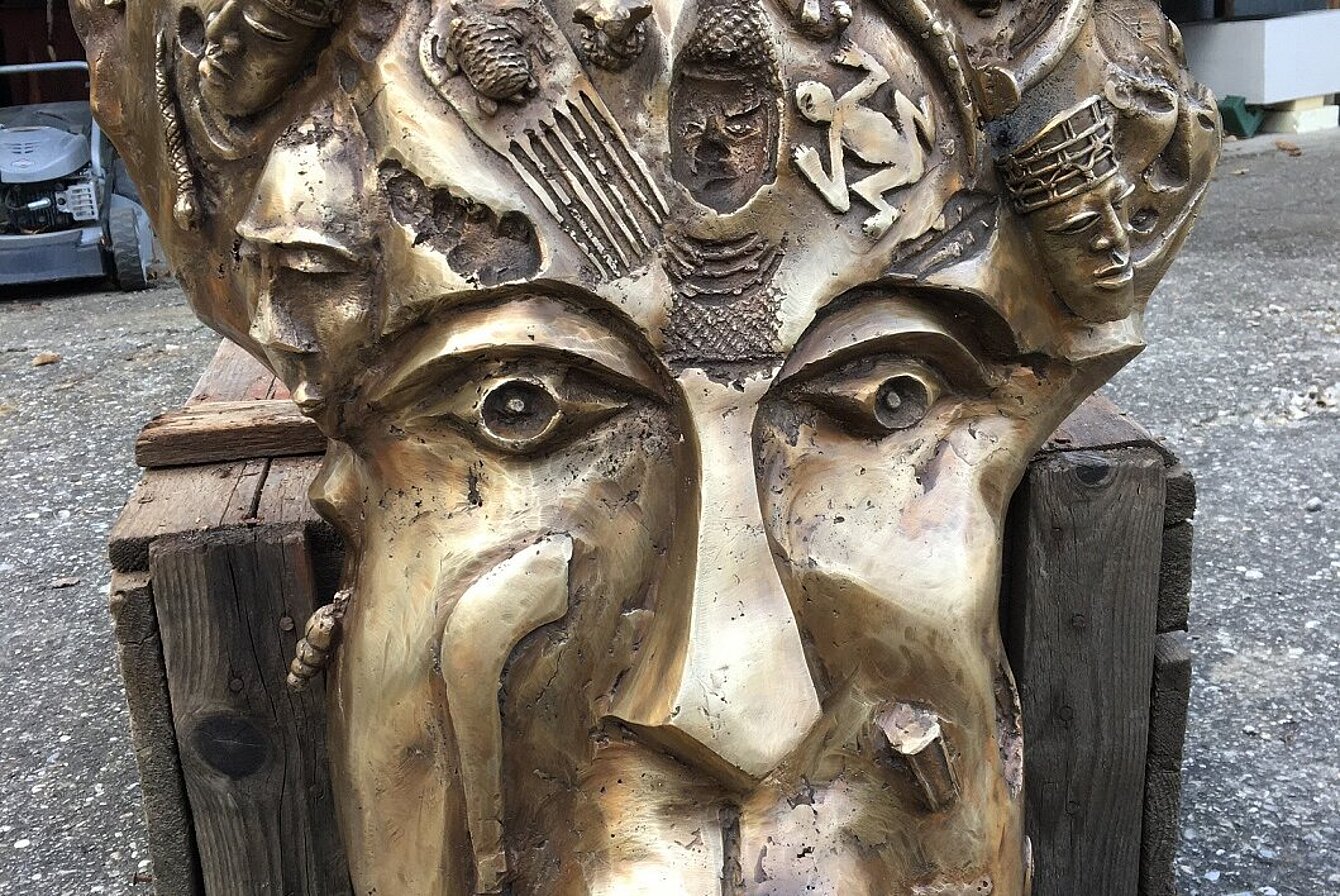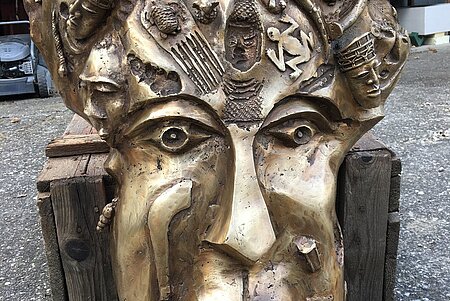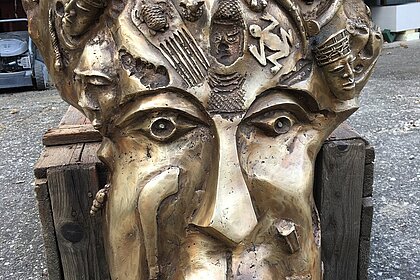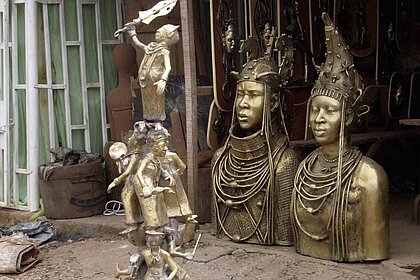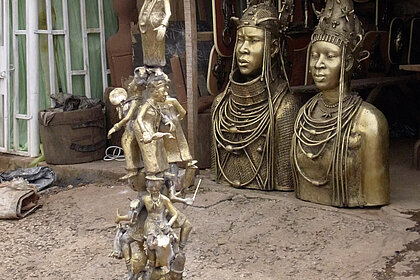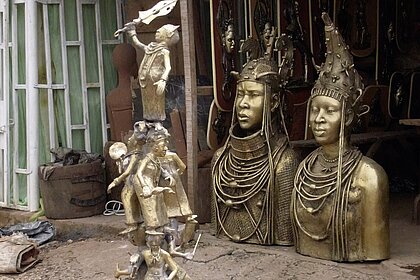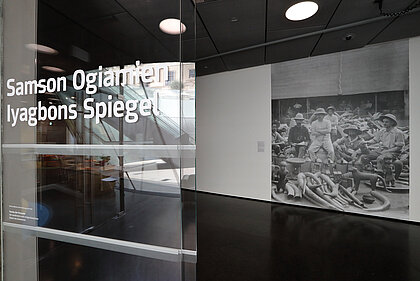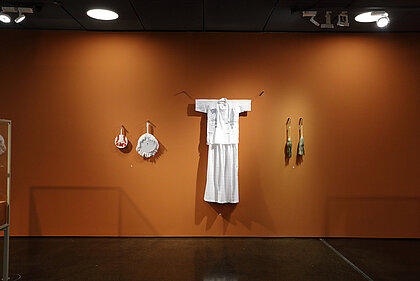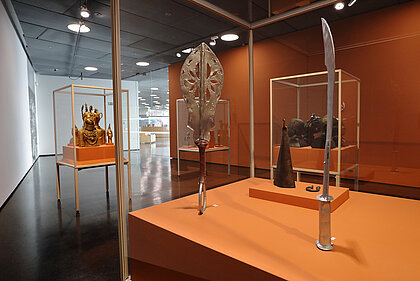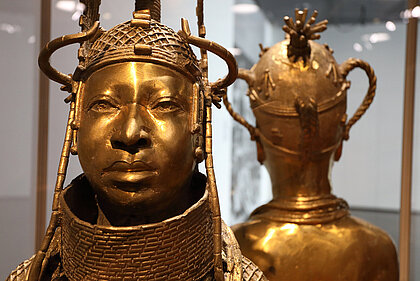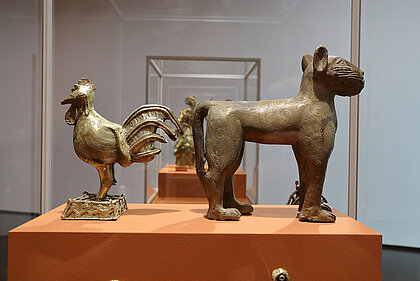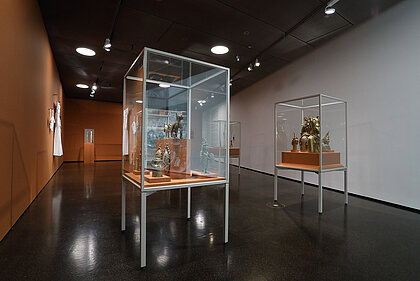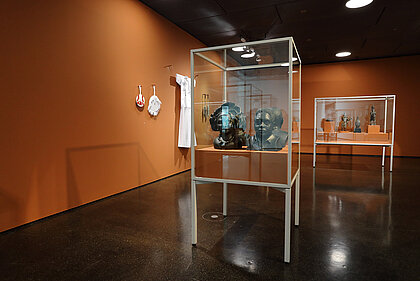I ask for Oluyenyetuye bronze of Ife
The moon says it is in Bonn
I ask for Ogidigbonyingboyin mask of Benin
The moon says it is in London
I ask for Dinkowawa stool of Ashanti
The moon says it is in Paris
I ask for Togongorewa bust of Zimbabwe
The moon says it is in New York
I ask
I ask
I ask for the memory of Africa
The seasons say it is blowing in the wind
The hunchback cannot hide his burden.
(Niyi Osundare, Africas Memory, 1998)
I ask for Uhunmwun Elao*, bronze head of Benin
The moon says it is in Vienna.
(Samson Ogiamien, 2021)
The discussion around the restitution of African artworks and their presentation in the countries of origin has been gaining momentum particularly in recent years. The research and publications of Felwine Sarr and Bénédicte Savoy represent the culmination of the discourse on this highly explosive problem field within the postcolonial discussion. Their restitution report on African cultural assets for the French president triggered a fierce debate across Europe.
Nigerian poet Niyi Osundare’s poem throws this problematic field into stark relief. Among many other things, colonisation despoiled the African countries and societies of their most important artworks and cultural objects. These countries were systematically pillaged under the pretext of teaching people to understand and appreciate them. In this way, as writer and ethnologist Michel Leiris points out, generation after generation was trained to “understand and appreciate” them. Vast numbers of artworks and cultural objects thus found their way to the Western world, filling ethnographic museums from Berlin to Vienna and from New York to Paris along with the international art market. In Africa itself, however, this dispersal of African heritage among the world’s museums led to a massive loss of memory. As early as the beginning of the 1970s, Mobutu, former Dictator of Zaire, pointed out that every rich Western country, even if it does not possess all the masterpieces of its best artists, has at least the bulk of them in the country. Thus, Italy has those of Michelangelo, Belgium, of Rubens; France, of Renoir; and Holland, many of Rembrandt or Vermeer. The paintings of Schiele or Kokoschka, of Picasso or Miró are most certainly not to be found in Mombasa, Kinshasa or Benin City. The art treasures of Africa, on the other hand, are mostly displaced from their original communities. How are subsequent generations there to be taught the history and culture of their countries?
The figures illustrating the pieces removed out of the various countries are staggering. Around 69,000 African objects are held by the British Museum, around 37,000 by the Weltmuseum in Vienna, 180,000 by the Africa Museum in Tervuren, 70,000 by the Musée du quai Branly and the Vatican Museums, and 75,000 by the prospective and controversial Humboldtforum in Berlin. The holdings of the African national museums, in contrast, comprise little more than 3,000 objects apiece, most of them of inferior quality (Sarr, Savoy).
In short, the recent debate has revealed that restitution not only implies physically returning objects to their countries of origin but also, and above all, involves acknowledging the illegality of possession. The act of restitution is thus an attempt to put things back in their proper place, also at an intellectual level. It stands to reason that this can never be about “all” of the pieces in Europe. There is a clear-cut hierarchy of objects that are significant and identity-defining for local communities and that were illegally appropriated. This sets out both a time frame and a moral basis upon which to enable a realistic movement in the right direction. Thus, we are not speaking of the thousands of drums and masks that poured into Europe from various sources, but rather of admissions of guilt, promoting understanding, and returning relatively few, if highly important objects to the respective communities. Most of them were not created as a “plaisir des yeux” but were rather embedded in various functional contexts of a ritual and spiritual nature and were therefore possessed of a significance completely different to the impression given in Western museums.
Court art from Nigeria, that for the most part developed from the 16th century onwards in and around the Royal Palace of Benin City, is perhaps the most well-known example in the context of looted art and restitution today. The bronze sculptures are remarkable for their aesthetic quality and age. The reason why we find this so astonishing today is perhaps due to the fact that Europeans long denied Africans a history or culture of any importance.
The fundamental significance of these objects pertains to religion and archival. These sculptures were made exclusively to royal order by members of the bronze casters’ guild. The Oba (king) would command a bronze cast to be made to mark major occasions. With the invention of photography a long way off, the bronzes were intended to record and document certain occurrences and individuals. Other works created for purposes other than commemoration served religious purposes and were housed in palace shrines. As a whole, the bronzes represented an archive and made the palace the centre of society in more ways than one. The tragic fate of these artworks is essentially due to a single historical event: the British punitive expedition of 1897, that resulted in the destruction of the Royal Palace of Benin City and the looting of the bronzes. These fateful circumstances led to the removal of the bronzes from the Royal Palace of Benin City to London as spoils of war, from where they were sold and gifted to various European countries and their museums. For decades, Nigeria has been pursuing the return of some of these cultural assets. The museum currently being built in Benin City is intended to lay another key foundation for expediting this process and putting the works back on display in their own country.
Samson Ogiamien, of royal descent on his father’s side and born as it were into the caster’s trade on his mother’s, is at the centre of this context. Having also trained as a sculptor in Austria (Ortweinschule Graz), not only does he stand between two cultural areas but also between two conceptions of art that could not be more different. On the one hand the self-assured contemporary artist who operates and defines himself by virtue of his authorship. On the other, the royal dignitary who explores secret processes as a spiritually initiated artist by virtue of his birth.
His art deals fundamentally with the structures of memory. For example, he has made portrait busts of people from Nigeria who died in Austria. At the same time, he often demonstrates how the special form of the bronze cast functions in its tradition and the importance it carries. In addition, he makes reference to his own social position as an artist both here and there, also addressing current questions of looted art and the restitution of artworks to Africa as a matter of course. By means of his art, that he pursues here in Europe, he can cast a special spotlight on the injustice and deplorable state of affairs with regard to cultural dynamics.
The exhibition and performance project impressively evinces the two components. Besides the contemporary products from Benin City, the project also features historical bronzes of the highest quality which point to the age-old tradition. But there are also a number of special objects on show, for example regalia owned by the artist himself that reflect his social standing and that are usually housed in the Royal Palace in Benin City. The exhibition makes reference to the aesthetics of classical ethnographic museums while also affording additional insights into the cultural background and religious contexts.
The collaboration with the French Onyrikon theatre company adds a fictional performance-based layer to the artistic, factual historical setting. The project brings into focus aspects of looting and spiritual transfiguration, history and current reality, both here and there.
The Neue Galerie Graz takes this opportunity to showcase Graz-based artist Samson Ogiamien and his work and thus to contribute to the discussion on restitution and cultural exchange. His path through life, his artistic reality, can be seen, as it were, as a positive example of how art, spirituality and social peculiarities can take place and coexist between two cultural areas.



















